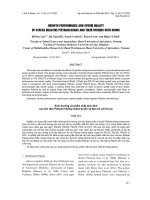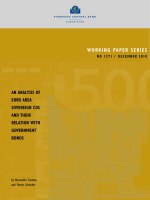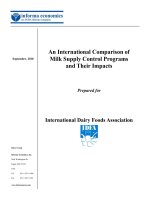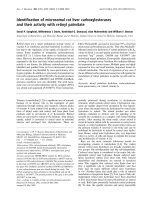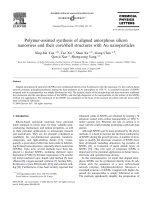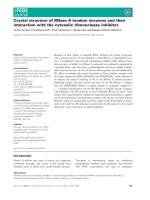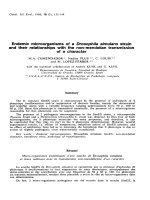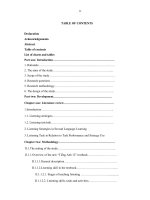Numerical modeling of three dimensional water waves and their interaction with structures
Bạn đang xem bản rút gọn của tài liệu. Xem và tải ngay bản đầy đủ của tài liệu tại đây (5.34 MB, 177 trang )
NUMERICAL MODELING OF THREE-DIMENSIONAL
WATER WAVES AND THEIR INTERACTION WITH
STRUCTURES
LIU Dongming
(B.Eng, TJU)
A THESIS SUBMITTED
FOR THE DEGREE OF DOCTOR OF PHILOSOPHY
DEPARTMENT OF CIVIL ENGINEERING
NATIONAL UNIVERSITY OF SINGAPORE
2007
To My Parents
i
Acknowledgements
First of all, I would like to express my sincere gratitude to my supervisor, Professor
Lin Pengzhi. I still remember when I joined NUS in 2003, I lacked in many things,
the clear concepts of fluid mechanics, the skills in programming, even the courage to
pursue the degree. Fortunately, I met a great supervisor, who showed his patience
and continuous support to me. Whenever I encountered a problem, he has always
been there for me. Besides helping me to solve the problems and sharing his inspiring
ideas, the most important thing he makes me understand is what is research and how
to do research. He always seizes every tiny problem and tries to solve it promptly,
which may waste me much more efforts and time if let it go. Such kind of critical
attitude and rigorous scholarship in research will accompany me in the rest of my life.
Without him, this thesis would never have been possible.
The thesis has b enefited by many other people’s works and efforts. The numerical
model developed in this study was first constructed by Dr. Wu Yongsheng, who
provided a very good beginning of the numerical model. The experimental data of
liquid sloshing were provided by Professor Koh Chan Ghee and Ms Gao Mimi at NUS.
Their works and generosity are appreciated.
ii
I would like to acknowledge the financial support provided by National University
of Singapore. I also would like to thank the technicians at Hydraulic Laboratory, es-
pecially Mr. Krishna Sanmugam and Ms. Norela Bte Buang for solving the computer
problems during my study.
Additional thanks go to my classmates, Mr. Man Chuanjian, Mr. Wang Dongchao,
Dr. Yu Xinying, Mr. Ma Qian, Mr. Zhang Dan, Mr. Zhang Wenyu, Mr. Lin
Quanhong, Mr. Chen Haoliang, Mr. Ma Peifeng, Mr. Shen Linwei, Mr. Li Liangbo,
Dr. Su Xiaohui, Dr. Gu Hanbin, Dr. Fernando and Dr. Anuja, for their friendship
and valuable discussion during the study. Special thanks go to Mr. Cheng Yonggang
for helping me to solve the problems of CAD and other softwares. Special thanks also
go to Mr. Xu Haihua for helping me to learn Tecplot. I also would like to thank my
other friends, Mr. Liu Changkun, Mr. Dai Shiyao, Mr. Li Ya, Dr. Lv Lu, etc. I
really spent a great time with all of you.
Last but not least, I would like to express my gratitude from the bottom of my
heart to my parents. Thank you very much for your continuous and invaluable support
in my life. I could not finish the whole study without the great love and care from
you.
iii
Table of Contents
Acknowledgements ii
Table of Contents iv
Summary viii
List of Tables x
List of Figures xi
List of Symbols xviii
1 Introduction 1
1.1 Background of Water Waves Modeling . . . . . . . . . . . . . . . . . . 1
1.2 Background of Navier-Stokes Equations Solver . . . . . . . . . . . . . . 7
1.3 Review of Turbulence Closure Models . . . . . . . . . . . . . . . . . . . 10
1.4 Objective and Scope of Present Study . . . . . . . . . . . . . . . . . . . 13
2 Mathematical Formulation of Numerical Model 16
2.1 Navier-Stokes Equations . . . . . . . . . . . . . . . . . . . . . . . . . . 16
iv
2.2 Spatially Averaged Navier-Stokes Equations and Large Eddy Simulation 17
2.3 Discussion of Initial and Boundary Conditions . . . . . . . . . . . . . . 19
2.3.1 Initial conditions . . . . . . . . . . . . . . . . . . . . . . . . . . 20
2.3.2 Boundary conditions . . . . . . . . . . . . . . . . . . . . . . . . 20
2.4 Summary of Governing Equations . . . . . . . . . . . . . . . . . . . . . 22
3 Numerical Implementation 24
3.1 Model Implementation . . . . . . . . . . . . . . . . . . . . . . . . . . . 24
3.1.1 Sketch of computational domain . . . . . . . . . . . . . . . . . . 24
3.1.2 Two-step projection method . . . . . . . . . . . . . . . . . . . . 27
3.1.3 Spatial discretization in finite difference form . . . . . . . . . . . 29
3.1.4 Volume of fluid method . . . . . . . . . . . . . . . . . . . . . . . 37
3.1.5 Computational cycle . . . . . . . . . . . . . . . . . . . . . . . . 44
3.2 Error Analysis and Numerical Stability . . . . . . . . . . . . . . . . . . 45
3.2.1 Error analysis . . . . . . . . . . . . . . . . . . . . . . . . . . . . 45
3.2.2 Numerical stability . . . . . . . . . . . . . . . . . . . . . . . . . 49
4 Liquid Sloshing in Confined Tanks 52
4.1 Review of Previous Works . . . . . . . . . . . . . . . . . . . . . . . . . 52
4.2 Free Sloshing . . . . . . . . . . . . . . . . . . . . . . . . . . . . . . . . 55
4.2.1 Oscillating liquids in a 2-D tank . . . . . . . . . . . . . . . . . . 55
4.2.2 Viscous damping in a 2-D tank . . . . . . . . . . . . . . . . . . 57
4.2.3 Sloshing in a 3-D tank . . . . . . . . . . . . . . . . . . . . . . . 62
v
4.3 Forced Sloshing . . . . . . . . . . . . . . . . . . . . . . . . . . . . . . . 69
4.3.1 Non-inertial reference frame . . . . . . . . . . . . . . . . . . . . 69
4.3.2 2-D linear liquid sloshing under surge excitation . . . . . . . . . 71
4.3.3 2-D nonlinear liquid sloshing under surge excitation . . . . . . . 74
4.3.4 2-D liquid sloshing under pitch excitation . . . . . . . . . . . . . 80
4.3.5 3-D linear liquid sloshing under coupled surge and sway excitation 82
4.3.6 3-D nonlinear liquid sloshing under coupled surge and sway ex-
citation . . . . . . . . . . . . . . . . . . . . . . . . . . . . . . . 85
4.3.7 3-D Violent sloshing with broken free surface . . . . . . . . . . . 90
4.4 Summaries . . . . . . . . . . . . . . . . . . . . . . . . . . . . . . . . . . 91
5 Virtual Boundary Force Method and Wave-structure Interaction 97
5.1 Introduction . . . . . . . . . . . . . . . . . . . . . . . . . . . . . . . . . 98
5.2 Review of Immersed Boundary Method . . . . . . . . . . . . . . . . . . 101
5.3 Virtual Boundary Force Method . . . . . . . . . . . . . . . . . . . . . . 102
5.4 Model Validation . . . . . . . . . . . . . . . . . . . . . . . . . . . . . . 108
5.4.1 Flow around a circular cylinder . . . . . . . . . . . . . . . . . . 108
5.4.2 Flow around a sphere . . . . . . . . . . . . . . . . . . . . . . . . 113
5.5 Non-breaking Solitary Wave Runup and Rundown on a Steep Slope . . 116
5.5.1 Experimental setup and numerical discretization . . . . . . . . . 116
5.5.2 Results and discussions . . . . . . . . . . . . . . . . . . . . . . . 118
5.6 Wave Diffraction around a Large Vertical Circular Cylinder . . . . . . . 124
vi
5.6.1 First order analytical solution . . . . . . . . . . . . . . . . . . . 124
5.6.2 Problem setup . . . . . . . . . . . . . . . . . . . . . . . . . . . . 127
5.6.3 Results and discussions . . . . . . . . . . . . . . . . . . . . . . . 130
5.7 Breaking Wave Interaction with Spar Platform in Deep Water . . . . . 130
6 Conclusions and Future Work 137
6.1 Conclusions . . . . . . . . . . . . . . . . . . . . . . . . . . . . . . . . . 137
6.2 Recommendations for Future Work . . . . . . . . . . . . . . . . . . . . 140
6.2.1 Background . . . . . . . . . . . . . . . . . . . . . . . . . . . . . 141
6.2.2 Liquid sloshing in a 3-D tank with rigid and moving baffles . . . 143
References 147
vii
Summary
A three-dimensional NumErical Wave TANK (NEWTANK) has been developed to
study water waves and wave-structure interaction. The numerical model solves the
incompressible spatially averaged Navier-Stokes (SANS) equations for the two-phase
flow. The large-eddy-simulation (LES) approach is adopted to model the turbulence
dissipation using the Smagorinsky sub-grid scale (SGS) closure. The two-step projec-
tion method is employed in the numerical solutions, aided by a Bi-CGSTAB technique
to solve the pressure Poisson equation for the filtered pressure field. The second-order
accurate volume-of-fluid (VOF) method, which is very efficient and robust, is used
track the highly distorted and broken free surface. A virtual boundary force (VBF)
method is proposed to simulate the structure of complex shape instead of applying the
conventional boundary condition around the structure. When a moving tank under
6 degree-of-freedom (D.O.F.) of motion is simulated, it will be constructed on the
non-inertial reference frame to avoid applying the complicated boundary condition.
The numerical model is first used to study free liquid sloshing in a confined tank,
including both 2-D and 3-D cases. The numerical results compare very well with
the linear analytical solution, Boussinesq results and the results calculated by other
viii
NSE solver. The model is then employed to study forced liquid sloshing in an excited
tank. For 2-D surge excitation, the numerical results of linear motion are compared
with the analytical solution while the results of nonlinear motion are compared with
the experimental data for free surface displacements. Good agreements are obtained.
Further studies are investigated on 3-D liquid sloshing. A linear analytical solution
is proposed for 3-D liquid sloshing under combined surge and sway excitations. The
model is validated by comparing the numerical results with the linear analytical so-
lution, experimental data and other numerical solutions. Finally, a demonstration of
violent liquid sloshing under 6 D.O.F. of motion with broken free surface in a 3-D
tank, which has not been investigated before, is presented and discussed.
Further investigations on wave-structure interactions are attempted and discussed.
The proposed VBF approach is employed to model surface-piercing structures. The
VBF method is first used to simulate a nonbreaking solitary wave runup and rundown
on a 2-D steep slope. The numerical results compare very well with experimental data
in terms of both free surface displacements and velocities. The model is then adopted
to study the 3-D wave diffraction by a large vertical circular cylinder. The numerical
results of the present mo del are compared with the well-known MacCamy and Fuchs
closed form analytical solution. Good agreements are obtained. Finally, the breaking
wave interaction with a spar platform in deep ocean is demonstrated and discussed.
ix
List of Tables
5.1 Comparisons of the drag co efficient C
D
, lift coefficient C
L
and Strouhal
number for the flow around a cylinder at Re = 100. . . . . . . . . . . . 113
5.2 Comparison of the drag coefficient C
D
for the flow around a sphere at
different Reynolds numb ers. . . . . . . . . . . . . . . . . . . . . . . . . 115
x
List of Figures
3.1 Schematic plot of mesh definition in present model. . . . . . . . . . . . 25
3.2 A single three-dimensional cell of the staggered grid. . . . . . . . . . . 26
3.3 Momentum control volumes for convections in x, y and z directions. . . 31
3.4 Calculation of VOF flux using PLIC method . . . . . . . . . . . . . . . 42
4.1 Non-uniform mesh system of free sloshing in a 2-D tank when the initial
slope of free surface S = 0.02. . . . . . . . . . . . . . . . . . . . . . . . 58
4.2 Comparisons of numerical results (dotted line) and analytical solution
(solid line) for water sloshing in a 2-D tank. . . . . . . . . . . . . . . . 59
4.3 Time series of the normalized mass. . . . . . . . . . . . . . . . . . . . . 60
4.4 Comparison of the time series τ of normalized free surface elevation
at x = 0 between the present numerical results using reference mesh
(25 ×23: circle), fine mesh (50 × 43: plus sign), coarse mesh (13 ×14:
dashed line) and analytical solution (solid line) when (a) Re = 20; (b)
Re = 200. . . . . . . . . . . . . . . . . . . . . . . . . . . . . . . . . . . 63
xi
4.5 Comparisons of the time series of normalized surface elevation η/H
0
at
the (a) center and (b) corner of the tank among the present numerical
results (dotted line), another NSE solver (Lin & Li, 2002) (dashed line),
the Boussinesq equation solver (Lin & Man, 2007) (dash-dot line) and
linear analytical solution (solid line) for H
0
/h
0
= 0.1. . . . . . . . . . . 66
4.6 Comparisons of the time series of normalized surface elevation η/H
0
at
the (a) center and (b) corner of the tank among the present numerical
results (dotted line), another NSE solver (Lin & Li, 2002) (dashed line),
the Boussinesq equation solver (Lin & Man, 2007) (dash-dot line) and
linear analytical solution (solid line) for H
0
/h
0
= 0.4. . . . . . . . . . . 67
4.7 Snap shots of free surface profiles during liquid sloshing at t = 0.0, 5.0,
10.0, 15.0, 20.0 and 25.0 s when H
0
/h
0
= 0.4. . . . . . . . . . . . . . . 68
4.8 Non-inertial reference frame for a 3-D tank under external excitation. . 70
4.9 Comparisons of free surface displacement at x = a in a horizontally
excited tank with (a) b = 0.01 m and ω = 0.5ω
0
; (b) b = 0.0004 m and
ω = 0.95ω
0
between the present numerical results (dotted line) and
analytical solution (solid line). . . . . . . . . . . . . . . . . . . . . . . . 73
4.10 The sketch of 2-D sloshing experiment. . . . . . . . . . . . . . . . . . . 75
4.11 Comparisons of the time series of surface elevation η at the position
of (a) probe 1; (b) probe 2; and (c) probe 3 between the present nu-
merical results (dashed line), the analytical solution (solid line) and
experimental data (circle) when ω = 0.583ω
0
. . . . . . . . . . . . . . . . 76
xii
4.12 Uniform mesh system of forced sloshing in a 2-D tank when ω = 1.0ω
0
. 78
4.13 Comparisons of the time series of surface elevation η at the position of
(a) probe 1; (b) probe 2; and (c) probe 3 among the present numerical
results (dashed line), the analytical solution (solid line), the numeri-
cal results of σ-coordinate model (Lin & Li, 2002) (dotted line) and
experimental data (circle) when ω = 1.0ω
0
. . . . . . . . . . . . . . . . . 79
4.14 Comparison of free surface displacement at the east boundary in a
container under forced pitch motion b etween present numerical results
(solid line) and that from Nakayama & Washizu (1981) (circles). . . . . 81
4.15 Top view of the 3-D experiment set of the tank on the shaker table. . . 83
4.16 Snap shots of free surface profiles during 3-D forced sloshing at t = 0.0,
4.0, 8.0, 12.0, 16.0 and 20.0 s. . . . . . . . . . . . . . . . . . . . . . . . 86
4.17 Comparisons of the time series of surface elevation η at the position (a)
(0.0, 0.155) and (b) corner (−0.285, −0.155) of the tank between the
present numerical results (dotted line), and linear analytical solution
(solid line). . . . . . . . . . . . . . . . . . . . . . . . . . . . . . . . . . 87
4.18 Comparisons of the time series of the normalized surface elevation
¯η = η/b at the position of (a) probe 1: (−0.265, 0.0) m, (b) probe 2:
(0.0, 0.135) m and (c) corner: (−0.285, −0.155) m of the tank between
the linear analytical solution (solid line), experimental data (circle)
and the present numerical results (b = 0.0005 m: cross; b = 0.005 m:
dashed line). . . . . . . . . . . . . . . . . . . . . . . . . . . . . . . . . . 89
xiii
4.19 Snap shots of violent sloshing at t = 0.4, 0.6, 0.9, 1.0, 1.2 and 1.6 s. . . 92
4.20 Numerical results of free surface displacement (left column) and energy
density spectra (right column) at (A) the center (0.0, 0.0); (B) the
position (−0.15, −0.08) m; and (C) the corner (−0.285, −0.155) m. . . 93
5.1 Illustration of VBF method that replaces the boundary condition on
the body surface with a virtual boundary force. . . . . . . . . . . . . . 103
5.2 Application of the VBF method for 2-D flow computation near a body
surface. . . . . . . . . . . . . . . . . . . . . . . . . . . . . . . . . . . . 106
5.3 Simulated vortex structure behind a circular cylinder for different Re;
the contours represent the normalized vorticity ωD/U with the interval
of 1.0. . . . . . . . . . . . . . . . . . . . . . . . . . . . . . . . . . . . . 110
5.4 Comparison of drag coefficient C
D
for circular cylinder between present
numerical results (circle) and the experiment results from Franzini &
Finnemore (1997) (solid line). . . . . . . . . . . . . . . . . . . . . . . . 112
5.5 Comparison of drag coefficient C
D
for sphere between present numerical
results (circle) and the experiment results from Franzini & Finnemore
(1997) (solid line). . . . . . . . . . . . . . . . . . . . . . . . . . . . . . 114
5.6 Computational domain of present model and the comparison of free
surface displacement between numerical results (solid line) and exper-
imental data (circle) at t = 5.68 s. . . . . . . . . . . . . . . . . . . . . . 117
xiv
5.7 Solitary wave runup and rundown at t = 6.38s: (a) Comparison of free
surface profiles (−: present model; arrows of velocity field are also from
present model; o: PIV data) and the dashed lines represent the position
of velocity gauge; (b) Comparisons of velocities at (b1) x = 6.3972 m,
(b2) x = 6.5556 m, and (b3) x = 6.7146 m (− & −−: u & w by present
model, o & *: u & w by PIV). . . . . . . . . . . . . . . . . . . . . . . . 119
5.8 Solitary wave runup and rundown at t = 6.58s: (a) Comparison of free
surface profiles (−: present model; arrows of velocity field are also from
present model; o: PIV data) and the dashed lines represent the position
of velocity gauge; (b) Comparisons of velocities at (b1) x = 6.3972 m,
(b2) x = 6.5556 m, and (b3) x = 6.7146 m (− & −−: u & w by present
model, o & *: u & w by PIV). . . . . . . . . . . . . . . . . . . . . . . . 121
5.9 Solitary wave run-up and rundown at t = 6.78s: (a) Comparison of free
surface profiles (−: present model; arrows of velocity field are also from
present model; o: PIV data) and the dashed lines represent the position
of velocity gauge; (b) Comparisons of velocities at (b1) x = 6.3972 m,
(b2) x = 6.5556 m, and (b3) x = 6.7146 m (− & −−: u & w by present
model, o & *: u & w by PIV). . . . . . . . . . . . . . . . . . . . . . . . 122
xv
5.10 Solitary wave run-up and rundown at t = 7.18s: (a) Comparison of free
surface profiles (−: present model; arrows of velocity field are also from
present model; o: PIV data) and the dashed lines represent the position
of velocity gauge; (b) Comparisons of velocities at (b1) x = 6.3972 m,
(b2) x = 6.5556 m, and (b3) x = 6.7146 m (− & −−: u & w by present
model, o & *: u & w by PIV). . . . . . . . . . . . . . . . . . . . . . . . 123
5.11 Solitary wave run-up and rundown at t = 7.38s: (a) Comparison of free
surface profiles (−: present model; arrows of velocity field are also from
present model; o: PIV data) and the dashed lines represent the position
of velocity gauge; (b) Comparisons of velocities at (b1) x = 6.3972 m,
(b2) x = 6.5556 m, and (b3) x = 6.7146 m (− & −−: u & w by present
model, o & *: u & w by PIV). . . . . . . . . . . . . . . . . . . . . . . . 125
5.12 Solitary wave run-up and rundown at t = 7.58s: (a) Comparison of free
surface profiles (−: present model; arrows of velocity field are also from
present model; o: PIV data) and the dashed lines represent the position
of velocity gauge; (b) Comparisons of velocities at (b1) x = 6.3972 m,
(b2) x = 6.5556 m, and (b3) x = 6.7146 m (− & −−: u & w by present
model, o & *: u & w by PIV). . . . . . . . . . . . . . . . . . . . . . . . 126
5.13 Computational domain of wave diffraction around a large vertical cir-
cular cylinder. . . . . . . . . . . . . . . . . . . . . . . . . . . . . . . . . 128
xvi
5.14 Mesh arrangements in x − z plane (left) and in x − y plane (right);
lines are plotted every two grid nodes for easier visibility. Filled parts
represent the circular cylinder. . . . . . . . . . . . . . . . . . . . . . . . 129
5.15 Comparisons of wave amplification along the circular cylinder among
the numerical results using VBF method (circle), the numerical results
using stair-step surface method (asterisk) and the analytical solution
by MacCamy & Fuchs (1954) (solid line). . . . . . . . . . . . . . . . . . 131
5.16 Schematic drawing of the spar platform in deep water. . . . . . . . . . 134
5.17 Snapshots of breaking wave impinging on a spar platform at t = 1.98,
2.49, 2.97, 3.57, 3.87, 4.17 s. . . . . . . . . . . . . . . . . . . . . . . . . 135
5.18 Time histories of in-line force (solid line), transverse force (dashed line),
and buoyancy force (dash-dot line) on the spar cylinder. . . . . . . . . 136
6.1 The sketch of the 3-D tank with baffles. . . . . . . . . . . . . . . . . . . 144
6.2 Comparisons of the sloshing free surface between the tank without baf-
fles (A-C) and with baffles (a-c) at t = 1.3, 1.4 and 1.5 s. . . . . . . . . 145
xvii
List of Symbols
a wave amplitude
A
n
wave amplitude of the n-th mo de
b displacement amplitude
c
i
wave celerity on the inflow boundary
c
0
phase celerity of the wave at the open boundary
C
s
Smagorinsky coefficient
C
D
drag force coefficient
C
L
lift (transverse) force coefficient
D
c
characteristic length scale
f external acceleration
f
V BF
virtual boundary force
F volume of fluid (VOF) function
F
2
(x), F
3
(x) Heaviside function
g
i
i-th component of the gravitational acceleration
k
r
residual kinetic energy
xviii
h still water depth
H wave height of the incident wave
H
0
initial height of the hump
H
(1)
m
Hankel function of the first kind of order m
J
m
Bessel function of the first kind of order m
k
n
wave number of the n-th mode
L wave length
L
s
Smagorinsky length scale
m normal vector
˜m unit normal vector for the new plane interface
m
n
1
, m
n
2
, m
n
3
x-, y- and z-components of the unit normal vector
M averaged mass flux
p pressure
p filtered pressure
P modified filtered pressure field
Re Reynolds number
p
D
dynamic pressure
p
h
hydrostatic pressure
r position vector of the considered point
R rotational motion origin
S interface slope
xix
t time
T wave period
U
c
characteristic velocity scale
u
c
compensation velocity
u
e
tank excitation velocity
u
i
i-th component of the velocity vector
u
i
i-th component of the filtered velocity
˜u
i
intermediate velocity
U
max
, V
max
, W
max
constant maximum velocities
V translational velocity of non-inertial reference frame
W filter width
α weighting factor
β peak enhancement factor
δ
ij
Kronecker delta
∆t time step size
∆x
i
grid lengths
ζ normalized wave elevation
˙
θ rotational velocity of non-inertial reference frame
µ molecular viscosity
µ
g
molecular viscosity of gas
µ
l
molecular viscosity of liquid
xx
µ
t
molecular eddy viscosity
ν kinematic viscosity
ρ density
ρ
g
density of gas
ρ
l
density of liquid
σ
ij
rate of the strain tensor
τ
R
ij
residual-stress tensor, or the SGS Reynolds stress
τ
r
ij
anisotropic residual-stress tensor component
τ
ij
molecular viscous stress tensor
τ
ij
viscous stress of the filtered velocity field
φ velocity potential function
φ
0
wave property
ϕ angle from the axis of oscillation
ω angular frequency of the excitation
ω
k
weighting function
ω
n
frequency of the n-th mode
ω
0
lowest natural frequency of fluid in the tank
Ω bounded domain
xxi
Chapter 1
Introduction
1.1 Background of Water Waves Mo deling
The study of water waves is of great importance in both coastal and offshore engi-
neering. For example, in nearshore coastal regions, waves can go through complex
transformation with the combination of wave shoaling, wave refraction, wave diffrac-
tion and wave breaking, so one of the most important engineering concerns for water
waves in nearshore region is the functional performance of various coastal protec-
tions, ranging from breakwater and groin to seawall and revetment. Most of these
protections are designed to provide a calm or at least reduced wave environment in
the protected areas such as harbors and beaches. On the other hand, in deep oceans
and offshore regions, wave height and wave period are two major concerns in de-
sign criteria. The practical problems include the safe operation of offshore structures
(eg. Floating Production Storage Offloading (FPSO) vessels or very large floating
airports) in extreme waves, the stability of offshore structures such as spar platforms
subjected to wave attacks, etc Other related problems such as the security of liq-
uefied natural gas (LNG) carriers under six degree-of-freedom (D.O.F.) of motions
CHAPTER 1. INTRODUCTION
are also very important and under intensive investigations. Furthermore, the study
in hazard mitigation of tsunami, which is usually generated by seismic disruption or
volcano eruption in deep oceans, is related to save people’s lives and properties near
coastal regions.
Generally speaking, there are four kinds of wave modelings to study a prototype
wave system, i.e., analytical modeling, empirical modeling, physical modeling and
numerical modeling. With their inherent advantages and disadvantages, these tech-
niques shall be applied for different purposes. First of all, a physical wave system
in nature can be very complicated. We may find a way to represent the wave sys-
tem by analyzing the system with a simplified theoretical model, which should be
able to capture the most important inherent characteristics of the wave system. Al-
though analytical modeling is a powerful tool to understand the physical phenomenon
of a particular wave system, the fluid equations can be solved analytically only for
a few simple cases, which greatly limits the application of this modeling to general
wave problems. Secondly, the empirical modeling is usually a simple mathematical
expression deriving from available field data of a prototype system. It can describe
the system behavior in terms of simple algebraic equations with important param-
eters. However, because all empirical formulas are established on known problems
and database, the existing empirical formulas will probably fail when a new system is
considered. Thirdly, a small-scale physical model in laboratory as the miniature of a
prototype system is an effective way to understand the prototype. Physical modeling
is straightforward most of time and allow us to visualize and understand the important
2
CHAPTER 1. INTRODUCTION
physical process from the small-scale model. Nevertheless, it may become extremely
difficult to build up a physical mo del which satisfies all important scaling laws when
a prototype system is very complicated. In addition, most of the physical models are
very expensive and time-consuming and some of the important parameters are not
that easy to measure or collect directly. Finally, as the development of computer tech-
nology, numerical modeling becomes more and more popular and important to study
water waves. A numerical wave model is the combination of mathematical represen-
tation of a physical wave problem and numerical approximation of the mathematical
equations. Compared to theoretical modeling, the difference is only in the means of
finding the solution of the governing equations for the wave problems. However, when
a numerical model is developed, some empirical parameters will be introduced which
may according to the experiments or field observation. From theoretical point of view,
most of the fluid problems can be described by the Navier-Stokes equation. However,
because of the constraint of the current computer power, it is impossible to resolve
all of the fluid problems, especially at high Reynolds number, using direct numerical
simulation. Therefore, turbulence model has to be adopted and the accuracy of the
turbulence model is needed to be tested and studied. These methods are correlated
and all very important and useful for studying a wave system.
The early numerical simulation of water waves was mainly based on the depth-
averaged equations (DAE), which include both shallow water equations (SWE) (Liu
et al., 1995) and Boussinesq equations (Peregrine, 1967). The energy dissipation due
to turbulence was incorp orated into the equations through certain simple dissipative
3
